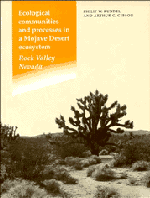Book contents
- Frontmatter
- Contents
- Preface
- Historical prologue on Rock Valley studies
- 1 Introduction to the Mojave Desert
- 2 Physical geography of Rock Valley
- 3 Adaptations of Mojave Desert plants
- 4 Desert perennials of southern Nevada
- 5 Mojave Desert annuals
- 6 Adaptations of Mojave Desert animals
- 7 Mammals
- 8 Reptiles
- 9 Birds
- 10 Arthropods
- 11 Soil organisms and seed reserves
- 12 Nitrogen cycling
- 13 Human impacts on Mojave Desert ecosystems
- References
- Species index
- Main index
8 - Reptiles
Published online by Cambridge University Press: 19 October 2009
- Frontmatter
- Contents
- Preface
- Historical prologue on Rock Valley studies
- 1 Introduction to the Mojave Desert
- 2 Physical geography of Rock Valley
- 3 Adaptations of Mojave Desert plants
- 4 Desert perennials of southern Nevada
- 5 Mojave Desert annuals
- 6 Adaptations of Mojave Desert animals
- 7 Mammals
- 8 Reptiles
- 9 Birds
- 10 Arthropods
- 11 Soil organisms and seed reserves
- 12 Nitrogen cycling
- 13 Human impacts on Mojave Desert ecosystems
- References
- Species index
- Main index
Summary
The herpetofauna of the Nevada Test Site (Table 8.1; Allred, Beck, & Jorgensen 1963; Tanner & Jorgensen 1963; Tanner 1969; O'Farrell & Emery 1976; BECAMP 1991a) consists of 15 species of lizards (suborder Sauria), 17 species of snakes (suborder Serpentes), and desert tortoise (Gopherus agassizii) order Testudines). The reptiles are ecologically diverse, occupying a full range of habitats from lowland desert scrub, playa margins, and washes to the highest pinyonjuniper (Pinus-Juniperus) woodland. Several characteristic species of the Mojave Desert have not been observed at NTS, but otherwise this preserve possesses an excellent profile of the regional reptiles and has been a prime location for studying their ecological characteristics.
REPTILES OF THE NEVADA TEST SITE AND ROCK VALLEY
Most species of reptiles that occur in Mojave Desert habitats at NTS (Table 8.1) are those also found nearby at Death Valley National Monument as well as in the southernmost localities at Joshua Tree National Monument (Miller & Stebbins 1964; Rowlands, Johnson, Ritter, & Endo 1982), although at each preserve some slightly distinctive geographical races may occur. All three preserves have populations of desert tortoises (G. agassizii). The three snake faunas are roughly comparable, but JTNM has more species because it has habitats supporting six species of rattlesnakes (Crotalus). None of the three preserves has reported the venomous Heloderma suspectum (banded gila monster), which is more common in the Colorado subdivision of the Sonoran Desert (Stebbins 1985); however, gila monsters have been sited near NTS on the north side of the Spring Mountain Range (Medica, pers. comm.).
- Type
- Chapter
- Information
- Publisher: Cambridge University PressPrint publication year: 1996



